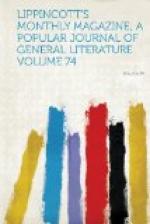A friend of mine, an American, who knew this country, had told me not to fail, while I was in the neighborhood, to go to S——. “Edward I. and Elizabeth,” he said, “are still hanging about there.” Thus admonished, I made a point of going to S——, and I saw quite what my friend meant. Edward I. and Elizabeth, indeed, are still to be met almost anywhere in the county: as regards domestic architecture, few parts of England are still more vividly Old English. I have rarely had, for a couple of hours, the sensation of dropping back personally into the past in a higher degree than while I lay on the grass beside the well in the little sunny court of this small castle, and idly appreciated the still definite details of mediaeval life. The place is a capital example of what the French call a small gentilhommiere of the thirteenth century. It has a good deep moat, now filled with wild verdure, and a curious gatehouse of a much later period—the period when the defensive attitude had been wellnigh abandoned. This gatehouse, which is not in the least in the style of the habitation, but gabled and heavily timbered, with quaint cross-beams protruding from surfaces of coarse white stucco, is a very picturesque anomaly in regard to the little gray fortress on the other side of the court. I call this a fortress, but it is a fortress which might easily have been taken, and it must have assumed its present shape at a time when people had ceased to peer through narrow slits at possible besiegers. There are slits in the outer walls for such peering, but they are noticeably broad and not particularly oblique, and might easily have been applied to the uses of a peaceful parley. This is part of the charm of the place: human life there must have lost an earlier grimness: it was lived in by people who were beginning to feel comfortable. They must have lived very much together: that is one of the most obvious reflections in the court of a mediaeval dwelling. The court was not always grassy and empty, as it is now, with only a couple of gentlemen in search of impressions lying at their length, one




